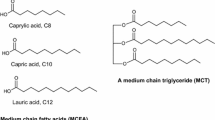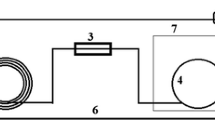Abstract
A method was developed for simultaneous determination of 13-hydroxyoctadecadienoic acid (13-HODE), 9,10-dihydroxyoctadecenoic acid (9,10-DHODE), and 9,10,13-trihydroxyoctadecenoic acid (9,10,13-THODE) in cured meat products. The analytes, extracted with methanol and cleaned by solid phase extraction, were separated on an XBridge C18 column (150*4.6 mm, 5 μm) with a mobile phase consisting of 0.1 % formic acid in water and acetonitrile, followed by detection with an electrospray ionization tandem mass spectrometry in negative-ion mode. The proposed method produced satisfactory reliability, sensitivity, and accuracy. Recoveries of the three analytes within the spiking range of 0.5–40 μg/g were 80.0–97.8 %, and limits of quantification of 13-HODE, 9,10-DHODE, and 9,10,13-THODE were 0.4, 0.025, and 0.05 μg/g, respectively. The method was successfully employed to detect the three fatty acids with hydroxyl(s) in cured meat products. It was shown that all samples contained the three analytes simultaneously, with concentrations ranging 1.40–100.77 μg/g for 13-HODE, 0.13–1.82 μg/g for 9,10-DHODE, and 0.49–10.12 μg/g for 9,10,13-THODE, respectively. The analytical result also indicated there were isomers of analytes, and the real content of fatty acids with hydroxyl(s) from oxidation of LA might be much higher.



Similar content being viewed by others
References
Baer AN, Costello PB, Green FA (1991) Stereospecificity of the hydroxyeicosatetraenoic and hydroxyoctadecadienoic acids produced by cultured bovine endothelial cells. BBA Lipid Lipid Metab 1085:45–52
Caligiuri SPB, Aukem HM, Ravandi A, Pierce GN (2014) Elevated levels of pro-inflammatory oxylipins in older subjects are normalized by flaxseed consumption. Exp Gerontol 59:51–57
Choque B, Catheline D, Rioux V, Legrand P (2014) Linoleic acid: between doubts and certainties. Biochimie 96:14–21
Contreras GA, Raphael W, Mattmiller SA, Gandy J, Sordillo LM (2012) Nonesterified fatty acids modify inflammatory response and eicosanoid biosynthesis in bovine endothelial cells. J Dairy Sci 95:5011–23
Ernst H, Oliw UG, Tomas N, Mirela C (2006) Payne rearrangement during analysis of epoxyalcohols of linoleic and a-linolenic acids by normal phase liquid chromatography with tandem mass spectrometry. Anal Biochem 354:111–126
Gardner HW (1989) Oxygen radical chemistry of polyunsaturated fatty acids. Free Radic Biol Med 7:65–86
Harrell MD, Stimers JR (2002) Differential effects of linoleic acid metabolites on cardiac sodium current. J Pharmacol Exp Ther 303:347–355
Huang YH, Li HJ, Huang T, Li F, Sun J (2014) Lipolysis and lipid oxidation during processing of Chinese traditional smoke-cured bacon. Food Chem 149:31–39
Jin GF, Zhang JH, Yu X, Zhang YP, Lei YX, Wang JM (2010) Lipolysis and lipid oxidation in bacon during curing and drying–ripening. Food Chem 123:465–471
Kim KR, Oh DK (2013) Production of hydroxy fatty acids by microbial fatty acid-hydroxylation enzymes. Biotechnol Adv 31:1473–1485
Kim H, Jang YS, Hou CT (2002) Effect of metal ions on the production of isomeric 9,10,13 (9,12,13)-trihydroxy-11E (10E)-octadecenoic acid from linoleic acid by pseudomonas aeruginosa PR3. Enzyme Microb Technol 30:752–757
Kobayashi N, Kaneda H, Kuroda H, Kobayashi M, Kurihara T, Watari J, Shinotsuka K (2000a) Simultaneous determination of mono-, di-, and trihydroxyoctadecenoic acids in beer and wort. J I Brewing 106:107–110
Kobayashi N, Kaneda H, Kuroda H, Watari J, Kurihara T, Shinotsuka K (2000b) Behavior of mono-, di-, and trihydroxyoctadecenoic acids during mashing and methods of controlling their production. J Biosci Bioeng 90:69–73
Konkel A, Schunck WH (2011) Role of cytochrome P450 enzymes in the bioactivation of polyunsaturated fatty acids. Biochim Biophys Acta 1814:210–222
Kühn H (1996) Biosynthesis, metabolization and biological importance of the primary 15-lipoxygenase metabolites 15-hydro(pero)XY-5Z,8Z,11Z,13E-eicosatetraenoic acid and 13-hydro(pero)XY-9Z,11E-octadecadienoic acid. Prog Lipid Res 35:203–226
Kuroda H, Kobayashi N, Kaneda H, Kaneda H, Watari J, Takashio M (2002) Characterization of factors that transform linoleic acid into di- and trihydroxyoctadecenoic acids in mash. J Biosci Bioeng 93:73–77
Lee SH, Williams MV, DuBois RN, Blair IA (2003) Targeted lipidomics using electron capture atmospheric pressure chemical ionization mass spectrometry. Rapid Commun Mass Spectrom 17:2168–2176
Levison BS, Zhang R, Wang Z, Fu X, DiDonato JA, Hazen SL (2013) Quantification of fatty acid oxidation products using online high-performance liquid chromatography tandem mass spectrometry. Free Radic Biol Med 59:2–13
Liu H, Joshi-Barve S, Barve S, McClain C, Ramsden C, Kirpich I (2013) Effects of ethanol and oxidized metabolites of linoleic acid on Caco-2 cell model of intestinal epithelial barrier. FASEB J 27(Meeting Abstracts):890.20
Markaverich BM, Mary A, Trellis T, Mani S, Reyna A, Portillo W, Sharp J, Turk J, Crowley JR (2007) Tetrahydrofurandiols (THF-diols), leukotoxindiols (LTX-diols), and endocrine disruption in rats. Environ Health Perspect 115:702–708
Moch D, Schewe T, Kühn H, Schmidt D, Buntrock P (1990) The linoleic acid metabolite 9DS-hydroxy-10,12(E, Z)-octadecadienoic acid is a strong proinflammatory mediator in an experimental wound healing model of the rat. Biomed Biochim Acta 49:201–207
Moghaddam MF, Grant DF, Cheek JM, Greene JF, Williamson KC, Hammock BD (1997) Bioactivation of leukotoxins to their toxic diols by epoxide hydrolase. Nat Med 3:562–566
Montine T, Quinn J, Kaye J, Morrow J (2007) F2-isoprostanes as biomarkers of late-onset Alzheimer’s disease. J Mol Neurosci 33:114–119
Newman JW, Watanabe T, Hammock BD (2002) The simultaneous quantification of cytochrome P450 dependent linoleate and arachidonate metabolites in urine by HPLC-MS/MS. J Lipid Res 43:1563–1578
Niki E (2009) Lipid peroxidation: physiological levels and dual biological effects. Free Radic Biol Med 47:469–84
Niki E, Yoshida Y, Saito Y, Noriko N (2005) Lipid peroxidation: mechanisms, inhibition, and biological effects. Biochem Biophys Res Commun 338:68–676
Ostermann AI, Willenberg I, Weylandt KH, Schebb NH (2014) Development of an online-SPE–LC–MS/MS method for 26 hydroxylated polyunsaturated fatty acids as rapid targeted metabolomics approach for the LOX, CYP, and autoxidation pathways of the arachidonic acid cascade. Chromatographia 78:415–428
Püssa T, Raudsepp P, Toomik P, Pällin R, Mäeorg U, Kuusik S, Soidla R, Rei M (2009) A study of oxidation products of free polyunsaturated fatty acids in mechanically deboned meat. J Food Compos Anal 22:307–314
Ramsden CE, Ringel A, Feldstein AE, Taha AY, MacIntosh BA, Hibbeln JR, Majchrzak-Hong SF, Faurot KR, Rapoport SI, Cheon Y, Chung YM, Berk M, Mann JD (2012) Lowering dietary linoleic acid reduces bioactive oxidized linoleic acid metabolites in humans. Prostaglandins Leukot Essent Fatty Acids 87:135–141
Reis A, Spickett CM (2012) Chemistry of phospholipid oxidation. BBA Biomembranes 1818:2374–2387
Saraswathi V, Hammock BD, Newman JW, Meerarani P, Toborek M, Hennig B (2003) Involvement of CYP 2C9 in mediating the proinflammatory effects of linoleic acid in vascular endothelial cells. J Am Coll Nutr 22:502–510
Serhan CN, Gotlinger K, Song H, Arita M (2004) Resolvins, docosatrienes, and neuroprotectins, novel omega-3-derived mediators, and their aspirin-triggered endogenous epimers: an overview of their protective roles in catabasis. Prostag Other Lipid Mediat 73:155–172
Spector AA (1999) Essentiality of fatty acids. Lipids 34:S1–S3
Spindler SA, Clark KS, Callewaert DM, Clark KS (1996) Significance and immunoassay of 9- and 13-hydroxyoctadecadienoic acids. Biochem Biophys Res Commun 218:187–191
Spindler SA, Clark KS, Blackburn ML, Bull AW, Reddy RG (1997) Occurrence of 13(S)-hydroxyoctadecadienoic acid in biological samples. Prostaglandins 54:875–880
Suo Y, Wang L (2010) Extraction of Nitraria tangutorum seed lipid using different extraction methods and analysis of its fatty acids by HPLC fluorescence detection and online MS identification. Eur J Lipid Sci Tech 112:390–399
Toldra F (2006) The role of muscle enzymes in dry-cured meat products with different drying conditions. Trends Food Sci Tec 7:164–168
Venkat NV, Venkatesh MS, Catherine R, Usman HM, Roy RR, Fiona C, Bernhard TB, Richard LK (2014) Hydroxyoctadecadienoic acids regulate apoptosis in human THP-1 cells in a PPARϒ-dependent manner. Lipids 49:1181–1192
Vestergaard CS, Schivazappa C, Virgili R (2000) Lipolysis in dry-cured ham maturation. Meat Sci 55:1–5
Wang DY, Zhang MH, Bian H, Xu WM, Xu XL, Zhu YZ, Liu F, Geng ZM, Zhou GH (2014) Changes of phospholipase A 2 and C activities during dry-cured duck processing and their relationship with intramuscular phospholipid degradation. Food Chem 145:997–1001
Yoshida Y, Kodai S, Takemura S, Minamiyama Y, Niki E (2008) Simultaneous measurement of F2-isoprostane, hydroxyoctadecadienoic acid, hydroxyeicosatetraenoic acid, and hydroxycholesterols from physiological samples. Anal Biochem 379:105–115
Zhu P, Peck B, Licea-Perez H, Callahan JF, Booth-Genthe C (2011) Development of a semi-automated LC/MS/MS method for the simultaneous quantitation of 14,15-epoxyeicosatrienoic acid, 14,15-dihydroxyeicosatrienoic acid, leukotoxin and leukotoxin diol in human plasma as biomarkers of soluble epoxide hydrolase activity in vivo. J Chromatogr B 879:2487–2493
Zurek G, Gee SJ, Hammock BD (2002) Development of an enzyme immunoassay for linoleic acid diols in urine. Anal Chim Acta 466:247–256
Author information
Authors and Affiliations
Corresponding author
Ethics declarations
Funding
This study was funded by National Natural Science Foundation of China (31401560) and Innovation of Agricultural Science and Technology of Jiangsu Province, China (CX(14)2117).
Conflict of Interests
Zhiming Geng has received a research grant from Agricultural Science and Technology Innovation Fund of Jiangsu Province, China. Daoying Wang has received a research grant from The National Natural Science Foundation of China (NSFC). Fang Liu has received a research grant from The National Natural Science Foundation of China (NSFC). Muhan Zhang has received a research grant from The National Natural Science Foundation of China (NSFC). Chong Sun declares that she has no conflict of interest. Hui Song declares that she has no conflict of interest. Haihong Wu declares that she has no conflict of interest. Shuang Ren declares that she has no conflict of interest.
Ethical Approval
This article does not contain any studies with human participants or animals performed by any of the authors.
Informed Consent
Not applicable.
Additional information
Hui Song and Haihong Wu contributed equally to this work.
Rights and permissions
About this article
Cite this article
Song, H., Wu, H., Geng, Z. et al. Simultaneous Determination of 13-HODE, 9,10-DHODE, and 9,10,13-THODE in Cured Meat Products by LC-MS/MS. Food Anal. Methods 9, 2832–2841 (2016). https://doi.org/10.1007/s12161-016-0470-1
Received:
Accepted:
Published:
Issue Date:
DOI: https://doi.org/10.1007/s12161-016-0470-1




